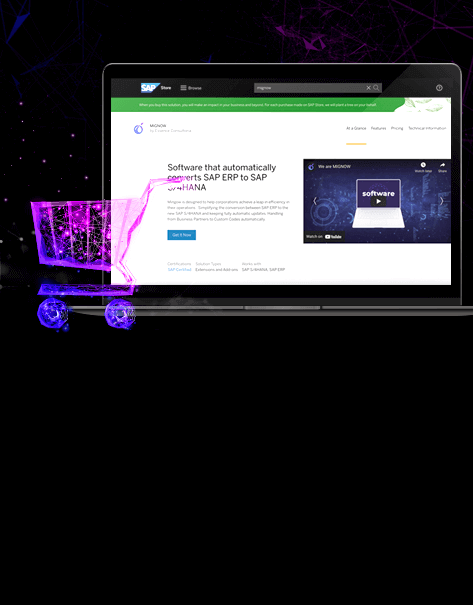In the current scenario of digital transformation, organizations are looking for solutions that optimize their internal processes, improve data control and simplify their operations.
System Applications and Products in Data Processing has played a crucial role in automating routine tasks such as reporting that once required manual efforts. Furthermore, robotic process automation adds a boost to the efficiency of daily activities.
As the digital landscape evolves, SAP is also undergoing a transformation to align with emerging trends such as Artificial intelligence the Internet of Things (IoT), blockchain and data analytics. This means that software users will need to migrate from SAP ECC to S/4HANA by the stipulated deadline in 2027. Failure to migrate could result in increased maintenance costs and loss of Enterprise Support.
OS/4HANA, compared to its previous version, was developed to adapt to the current operating model of organizations. It is more flexible in relation to changes, acquisitions and the incorporation of new sales channels. The growing need for this flexibility is seen as companies expand into new markets and integrate products from smaller brands through acquisitions. OS/4HANA allows companies to maintain these acquisitions in an SAP public cloud environment, eliminating the complexity of embedding them directly into the core system.
Furthermore, S/4HANA presents a considerable improvement in terms of speed. Through intelligent data design, the system reduces redundancy and aggregation of information, resulting in faster analysis and insights. The integration of commercial transactions and analytical resources in the same system speeds up decision-making and process execution, consolidating all these functionalities in a single application and a single source of information. In addition to these benefits, migration is associated with a significant reduction in 30% in operational costs, with savings of 20% in stock and a notable streamlining of 50% in billing processing times.
Migration models for SAP ECC to S/4HANA
The success of migration depends, to a large extent, on the chosen strategy. Three main models appear as options: brownfield, greenfield, Bluefield/Shell Conversion.
- Brownfield preserves all history and configuration data, making it suitable for young companies or those that are already aligned with the SAP standard. Renowned companies such as Pay Less, Localiza, Safra and Raia Drogasil, used this model, representing 73,5% of migration, according to research carried out by Mignow.
- On the other hand, Greenfield involves complete installation and configuration, allowing you to test third-party innovations and systems. This model is found in 5,9% of migrations.
- For complex companies with sophisticated structures, the Bluefield or Shell Conversion model stands out as the best alternative. This model combines characteristics of the Brownfield and Greenfield models, allowing the organization to select the data to be leveraged.
With this approach, you can start SAP from scratch and run separate processes for different business codes, optimizing system downtime and including specific data in the conversion. Companies like Centauro and Grupo Petrópolis chose this model, which also corresponds to 5,9% of migration, according to the research.
Research also indicates that 14,7% of those interviewed do not know the models or do not know which one to use in their migration. To choose the best migration option for each organization, it is recommended that there be an internal study, involving databases, sectors, employees and the company's own reading of the system, which includes the magnitude of the organization, system versions, size, plugins integrated, amount of customized codes and the so-called “Z's”, which are organization-specific extensions that will not use SAP. This stage, called assessment, is a self-discovery of the company, is part of the pre-project, and is fundamental for a more effective migration with a lower error rate.
Selecting the appropriate migration model requires a comprehensive internal assessment, taking into account factors such as organization size, current system configurations, customizations, amount of custom code, and company-specific extensions. This evaluation process is crucial to minimizing errors and ensuring a successful migration.
Another crucial decision involves choosing between a physical data center and migrating to the cloud. SAP offers the solution Rise with SAP, which enables the adoption of cloud services, such as Google or Microsoft. The choice between migration models and infrastructure option can influence the efficiency of the process and the results achieved.
Highlighting the importance of the company responsible for migrating from ECC to S/4HANA is imperative. A personalized analysis is essential to guide the organization in selecting the ideal strategy, from the evaluation phase to making decisions about partial or full data migration, as well as the choice of infrastructure. These factors directly impact the success of the migration, affecting both the time and costs involved.
See where this article was published!

From ECC to S/4HANA Migration: A Guide to Success in the Era of Digital Transformation
–

From ECC to S/4HANA: A Guide to a Successful Migration
–

A Guide to Success in the Era of Digital Transformation
–

A Guide to Successful Migration in the Era of Digital Transformation
CONTENT LINK
–

A Guide to Successful Migration in the Era of Digital Transformation
CONTENT LINK
–

From ECC to S/4HANA Migration: A Guide to Success in the Era of Digital Transformation
CONTENT LINK
–
![]() From ECC to S/4HANA Migration: A Guide to Success in the Era of Digital Transformation
From ECC to S/4HANA Migration: A Guide to Success in the Era of Digital Transformation
CONTENT LINK



